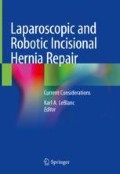Abstract
Since its advent in 1993, laparoscopic incisional hernia repair has undergone significant evolution. One such evolution is the closure of the fascial defect, which was not a part of the initial intraperitoneal onlay mesh repair described by LeBlanc. The current literature on advantages and disadvantages associated with closure of the fascial defect laparoscopically is inconclusive, with no improvement in recurrence rates. However, closure of the fascial defect is associated with improved patient satisfaction and a better cosmetic result. The fascial defect can be closed intraperitoneally or extraperitoneally. The advent of robotic platforms has allowed for the dexterity required to close the fascial defect, especially against the anterior abdominal wall. Given the minimal increased risk, laparoscopic fascial defect closure should be performed when feasible.
Access this chapter
Tax calculation will be finalised at checkout
Purchases are for personal use only
References
Wechter ME, Pearlman MD, Hartmann KE. Reclosure of the disrupted laparotomy wound. Obstet Gynecol. 2005;106:376–83. https://doi.org/10.1097/01.aog.0000171114.75338.06.
Cengiz Y, Israelsson LA. Incisional hernias in midline incisions: an eight-year follow up. Hernia. 1998;2:175–7. https://doi.org/10.1007/bf01569142.
Mudge M, Hughes LE. Incisional hernia: a 10 year prospective study of incidence and attitudes. Br J Surg. 1985;72:70–1. https://doi.org/10.1002/bjs.1800720127.
Pans A, Elen P, Dewé W, Desaive C. Long-term results of polyglactin mesh for the prevention of incisional hernias in obese patients. World J Surg. 1998;22:479–83. https://doi.org/10.1007/s002689900420.
Trimbos JB. A randomized clinical trial comparing two methods of fascia closure following midline laparotomy. Arch Surg. 1992;127:1232. https://doi.org/10.1001/archsurg.1992.01420100094016.
Luijendijk RW. A comparison of suture repair with mesh repair for incisional hernia. N Engl J Med. 2000;343:392–8.
Poulose BK, Shelton J, Phillips S, Moore D, Nealon W, Penson D, et al. Epidemiology and cost of ventral hernia repair: making the case for hernia research. Hernia. 2011;16(2):179–83.
LeBlanc KA, Booth WV. Laparoscopic repair of incisional abdominal hernias using expanded polytetrafluoroethylene: preliminary findings. Surg Laparosc Endosc. 1993;3(1):39–41.
Itani KMF, Hur K, Kim LT, Anthony T, Berger DH, Reda D, Neumayer L. Veterans Affairs Ventral Incisional Hernia Investigators. Comparison of laparoscopic and open repair with mesh for the treatment of ventral incisional hernia a randomized trial. Arch Surg. 2010;145(4):322–8. https://doi.org/10.1001/archsurg.2010.18.
Banerjee A, Beck C, Narula VK, Linn J, Noria S, Zagol B, et al. Laparoscopic ventral hernia repair: does primary repair in addition to placement of mesh decrease recurrence? Surg Endosc. 2011;26(5):1264–8.
Tandon A, Pathak S, Lyons NJR, Nunes QM, Daniels IR, Smart NJ. Meta-analysis of closure of the fascial defect during laparoscopic incisional and ventral hernia repair. Br J Surg. 2016;103(12):1598–607.
Clapp M, Awad S, Subramanian A, Liang M. Trans-cutaneous closure of central defects (TCCD) in laparoscopic ventral hernia repairs (LVHR). J Surg Res. 2012;172(2):286–7.
Suwa K, Okamoto T, Yanaga K. Closure versus non-closure of fascial defects in laparoscopic ventral and incisional hernia repairs: a review of the literature. Surg Today. 2015;46(7):764–73.
Wennergren JE, Askenasy EP, Greenberg JA, Holihan J, Keith J, Liang MK, et al. Laparoscopic ventral hernia repair with primary fascial closure versus bridged repair: a risk-adjusted comparative study. Surg Endosc. 2015;30(8):3231–8.
Allison N, Tieu K, Snyder B, Pigazzi A, Wilson E. Technical feasibility of robot-assisted ventral hernia repair. World J Surg. 2011;36(2):447–52.
Chelala E, Baraké H, Estievenart J, Dessily M, Charara F, Allé JL. Long-term outcomes of 1326 laparoscopic incisional and ventral hernia repair with the routine suturing concept: a single institution experience. Hernia. 2015;20(1):101–10.
Nguyen DH, Nguyen MT, Askenasy EP, Kao LS, Liang MK. Primary fascial closure with laparoscopic ventral hernia repair: systematic review. World J Surg. 2014;38(12):3097–104.
Zeichen MS, Lujan HJ, Mata WN, Maciel VH, Lee D, Jorge I, Plasencia G, Gomez E, Hernandez AM. Closure versus non-closure of hernia defect during laparoscopic. ventral hernia repair with mesh. Hernia. 2013;17(5):589–96.
Carter SA, Hicks SC, Brahmbhatt R, Liang MK. Recurrence and pseudorecurrence after laparoscopic ventral hernia repair: predictors and patient-focused outcomes. Am Surg. 2014;80(2):138–48.
Recommended Reading
Karipineni F, Joshi P, Parsikia A, Dhir T, Joshi A. Laparoscopic-assisted ventral hernia repair: primary fascial repair with polyester mesh versus polyester mesh alone. Am Surg. 2016;82(3):236–42.
Light D, Bawa S. Trans-fascial closure in laparoscopic ventral hernia repair. Surg Endosc. 2016;30(12):5228–31.
Misiakos EP, Patapis P, Zavras N, Tzanetis P, Machairas A. Current trends in laparoscopic ventral hernia repair. J Soc Laparoendosc Surg. 2015;19(3):e2015.00048.
Tayar C, Karoui M, Cherqui D, Fagniez PL. Robot-assisted laparoscopic mesh repair of incisional hernias with exclusive intracorporeal suturing: a pilot study. Surg Endosc. 2007;21(10):1786–9.
Author information
Authors and Affiliations
Corresponding author
Editor information
Editors and Affiliations
Rights and permissions
Copyright information
© 2018 Springer International Publishing AG, part of Springer Nature
About this chapter
Cite this chapter
Madabhushi, V., Scott Roth, J. (2018). Laparoscopic Closure of Fascial Defect. In: LeBlanc, K. (eds) Laparoscopic and Robotic Incisional Hernia Repair. Springer, Cham. https://doi.org/10.1007/978-3-319-90737-6_6
Download citation
DOI: https://doi.org/10.1007/978-3-319-90737-6_6
Published:
Publisher Name: Springer, Cham
Print ISBN: 978-3-319-90736-9
Online ISBN: 978-3-319-90737-6
eBook Packages: MedicineMedicine (R0)

